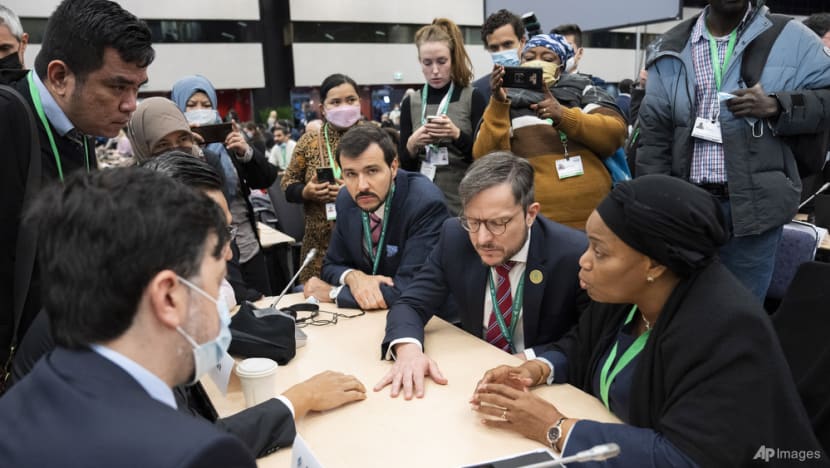'We could do better': Experts 'guardedly optimistic' about historic COP15 deal
An environment professor from the Australian National University said that developed countries need to be generous in providing conservation aid to developing countries.

Eve Bazaiba Masudi, Vice Prime Minister and Environment Minister of the Democratic Republic of Congo and Brazil Foreign Minister Leonardo Cleaver de Athayde, confer with other delegates at the COP15 UN conference on biodiversity in Montreal, on Dec 19, 2022. (Photo: AP/The Canadian Press/Paul Chiasson)
SINGAPORE: A historic deal to protect nature and direct billions of dollars towards conservation is overall a “good success”, but is “far from a perfect deal”, an expert said on Tuesday (Dec 20).
The agreement recorded at UN biodiversity summit COP15 contains 23 targets aimed at halting decades of human-caused environmental destruction threatening the world’s species and ecosystems.
Nearly 200 countries pledged to secure 30 per cent of the planet as a protected zone by 2030 under the deal called Kunming-Montreal Global Biodiversity Framework.
The governments have essentially doubled their ambition to protect habitat areas on land, as well as freshwater and saltwater ecosystems by 2030, noted Professor Jamie Pittock from the Australian National University’s Fenner School of Environment & Society.
“In some ways, this is the Paris conference equivalent for climate being replicated for biodiversity conservation,” he told CNA's Asia First, referring to the landmark climate plan signed in 2015 to limit global warming to 1.5 degrees Celsius.
“That's really pleasing but we could do better.”
More than 1 million species could vanish by the century's end, from plants to insects, in what scientists have called a sixth mass-extinction event. As much as 40 per cent of the world's land has been degraded, and wildlife population sizes have shrunk dramatically since 1970.
Despite previous agreements failing to help the decline of the Earth’s biodiversity and ecosystems, Dr Shawn Lum said he is “guardedly optimistic” about the recently signed plan.
One of the differences is the buy-in from the private sector in the current deal, said Dr Lum, senior lecturer in the Nanyang Technological University’s Asian School of the Environment.
The framework covers aligning public and private financial flows and large companies disclosing their environmental impacts and how dependent their profits are on ecosystems.
For instance, the finance sector is constantly searching for transparency and ecological footprint of their activities, Dr Lum told CNA's Singapore Tonight. The financial markets are waking up to the urgency to protect nature, he said.
“I think it's going to be a big part of their business model going forward, I think we will see a change in the way people view financing,” he said.
ISSUES WITH FUNDING
Under the agreement, countries will commit to spending US$200 billion per year on conservation by the end of the decade, which will include public, private, and philanthropic support.
The amount includes the US$25 billion in annual funding developed countries are expected to provide to the developing world starting in 2025. The figure will go up to US$30 billion per year by 2030.
The amount pledged by developed countries to help developing nations, despite the landmark commitment, was not enough, Prof Pittock said.
“What's really needed is the order of magnitude for funding. There are existing mechanisms, such as the global biodiversity facility that the World Bank oversees. So, there's the mechanisms to do it. We really need developed countries to be more generous,” he said.
One argument is that the global north has really benefited from the exploitation of the south, said Dr Lum. The global north refers to nations of the world which are characterised by a high level of economic and industrial development, and are typically located to the north of less industrialised nations while the global south refers to nations on the other end of the spectrum.
“I think we need a bit more equitable system, but at least there is a framework for both government and private sector to make available US$200 billion annually,” he said.
“Important specifics need to be sorted out, but I think there's this agreement that this has to be done. It has to be inclusive, it has to be equitable,” Dr Lum added.
ROLE OF CHINA, SOUTHEAST ASIA
The role of China, which was in charge of the meeting, is “critical”, said Prof Pittock.
“In some ways, they’ve (China has) been a bit of a bridge builder between developing and developed nations here. It's notable that in the presidency of this conference, China collaborated with a number of Western governments,” he said, adding that this includes countries they have been in disputes with.
He added that as one of the world's largest economies, China has a key role in adopting more sustainable practices in its manufacturing and its energy supply, which will go a long way towards conserving biodiversity.
“China can really set the global example for those countries with emerging economies. That will be crucial if we are to both conserve our flora and fauna, and reduce climate change by the middle of this century,” he said.
Dr Lum said that Singapore can also play a role, given that there is a lot at stake and the need for regional cooperation.
“If you look at Singapore and all the capacity it has, whether in technology, education, finance, communication, in all these different areas, I think Singapore could really be a hub, working with regional governments,” he said.
“If you think about what Southeast Asia has - the world's richest coral reefs, wetlands, mangroves, peatlands, all of these things that not only have biodiversity but are so important for regulating the planet and providing livelihoods for hundreds of millions of people.”
LOOKING AHEAD
While the previous targets from COP10 were not achieved by the 2020 deadline, Prof Pittock noted that there was “a lot of progress”.
For instance, the area of land-based habitats protected increased to 15 per cent of the planet’s area, just shy of the 17 per cent target. He expects more progress under the current framework.
“With the added urgency to conserve biodiversity with the co-benefits in reducing greenhouse gas pollution, with the greater cooperation that we're now seeing between China, who held the presidency for this conference, and developed countries, I'm hopeful that we will make a lot of progress between now and 2030,” he said.
He added that the next edition of the summit, expected to be held in 2024, would be useful to revisit the question of how to finance the targets that have been adopted this week.
A few of the targets have “some ambiguous wording”, he noted. He cited the measures that have been proposed to reduce pollution and decrease the consumption of natural resources to sustainable levels to protect threatened species.
It would be good if the next conference tightens up the wording and be more precise about what the governments need to achieve, he added.
Under the Convention on Biological Diversity, each of the 196 international governments has to prepare a national biodiversity plan, he said.
“That's where the rubber hits the road and it would be good to see by the next conference … most of those governments, having updated their plans to show precisely what they're promising to do, so they can be held accountable,” he said.















